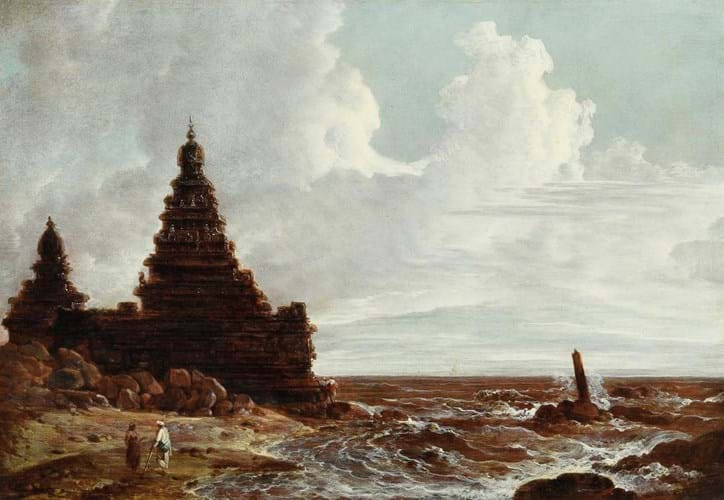The topographical views of India produced by the artist and his nephew William Daniell (1767-1837) during their seven-year tour in the subcontinent from 1786-93 have undergone strong commercial growth in recent years. Helped by ever-increasing interest from Indian bidders, including from some new collectors discovering their works online, high prices have come for both prints and original pictures by the Daniell duo of late.
Recognisable views are favoured, especially those depicting key religious centres and historical sites that appeared in their famous series of plate books – publications which brought much of the scenery and architecture of India to a European audience for the first time.
The good run continued at Dreweatts (26/25% buyer’s premium) in Newbury on February 21 when a Thomas Daniell painting of the Shore Temple in Mahabalipuram drew strong competition against a £30,000-50,000 estimate.
Key location
The site near Chennia, part of a complex of temples and shrines that dates back to c.725AD, was recorded by both artists. This 14¾ x 21¼ in (38 x 54cm) oil on mahogany panel showed the main shrine, a granite five-storied pyramidal structure overlooking the shore of the Bay of Bengal.
It was almost certainly painted in 1793 while the Daniells were based at Madras. The back was inscribed: A Hindoo Temple at Mauveleporam – on the Coast of Coromandel in East Indies.
The location augured well for the sale, especially since a large-scale view of the excavated entrance to the temple fetched $850,000 (£686,550) at Christie’s New York in January 2023, an auction record for Thomas Daniell.
William Daniell later produced an engraving of the Shore Temple, perhaps derived from the current view, which was published in The Oriental Annual, or, Scenes in India of 1834. The accompanying text of the plate mentions that the temple “is of compact and beautiful stone-work, and stands upon a rock jutting from the land into the sea, it is a remnant, such at least in the oral tradition of the place, of an ancient city, which has been overthrown by the constantly encroaching waters, and of which this structure alone remains entire.”
The fact that the picture in Newbury was a panel painting made it highly unusual – most of Thomas’ paintings were on canvas and only a handful on panel are known. It came to auction from a private collection where it had been since c.1960. The condition was largely good and untouched with only some minor retouching in places.
Dreweatts said that, on close inspection, the brush strokes remained remarkably fresh, subtly capturing the movement of the waves and figures.
With so much in its favour, not least the current strength of demand for works by the Daniells, multiple bidders turned out on the day from both the UK and Asia. It was eventually knocked down to a private collector in Asia at £165,000 – a strong sum for a smaller-format painting such as this and one of the highest-ever sums for Thomas Daniell sold at an auction outside of London.















